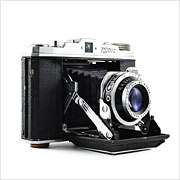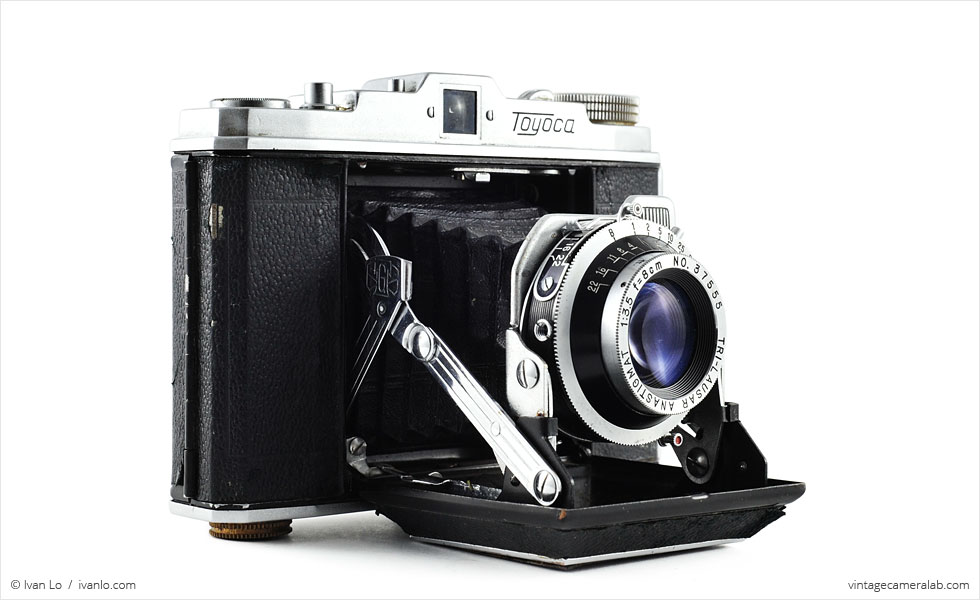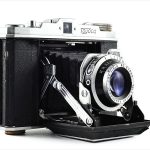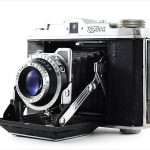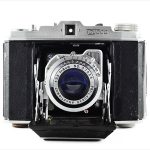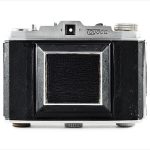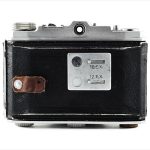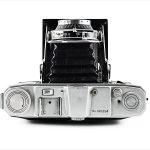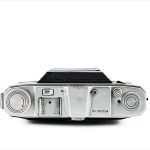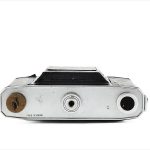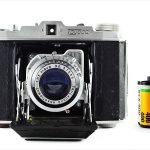Toyoca Six Specifications
| Manufacturer: | Toyohashi Y.K. Tougodo |
| Origin: | Japan |
| Made in: | Toyohashi, Aichi, Japan |
| Introduced: | 1957 |
| Type: | Folding, Viewfinder |
| Format: | 120 Film |
| Dimensions: | 14 x 10.4 x 5 cm (closed) |
| 14 x 10.4 x 10.8 cm (open) |
Toyoca Six Overview
The Toyoca Six is an extremely rare dual format folding camera introduced in 1957 by Toyohashi Y.K. Tougodo under the brand name Toyoca, a contraction of “Toyohashi” (the city in which the company was based at the time) and “Camera.” The other part of the name, “Tougodo,” was named after one of Japan’s most famous naval heroes, Admiral Togo Heihachiro who shared a hometown with one of the company’s founders.
The Six features a Tri-Lauser Anastigmat 80mm f/3.5 lens made by the Tomioka Optical Co., a company which would later become part of Yashica. Mated to the lens is a shutter capable of speeds ranging from 1 to 1/300 seconds and Bulb. The Focus can be set by rotating the silver ring surrounding the lens, the shutter speed can be adjusted by rotating the thin, knurled ring on just behind it, and the aperture can be chosen by moving a metal bracket behind the shutter speed selector. A shutter cocking lever can be found at the 12:00 position on the lens barrel, a flash sync post at 1:30, a self-timer lever at 5:00, and a shutter release cable socket at 9:00.
As stated before, the Six can shoot 120 film in both 6×6 and 6×4.5 formats thanks to adjustable flaps inside the camera; red windows for both sizes can be revealed on the back to keep track of the frame count. The film advance knob can be found on the user’s left hand side of the top plate right next to the cold shoe and chrome lens release button. In the center of the top plate is the viewfinder and right next to it is a very tiny knurled cylinder which, when rotated with your fingertip, engages or disengages a viewfinder overlay to simulate the visual difference between the formats, showing a skinnier frame for 4.5x6cm mode and wider for 6x6cm mode. Last but not least, the shutter button can be found to the right of the viewfinder frame selection knob.
In regards to its rarity, there are supposedly only a handful of surviving examples known to be in existence. One of them was owned by the Pentax‘s camera museum in Tochigi Prefecture which was unfortunately closed down in 2009 while the others, like mine, are presumably in private collections. I bought this incredibly rare camera via an eBay auction posted by a collector in British Columbia. Perhaps due to the camera’s rarity and its relatively unknown brand, there was very little competition and I managed to get the camera for a little under $50.
Find your very own Toyoca Six on eBay.
McKeown, James M. and Joan C. McKeown’s Price Guide to Antique and Classic Cameras, 2001-2002. (Grantsburg, WI, USA: Centennial Photo Service, 2001), p 639.
“Toyoca Six,” Camera Wiki, http://camera-wiki.org/wiki/Toyoca_Six
